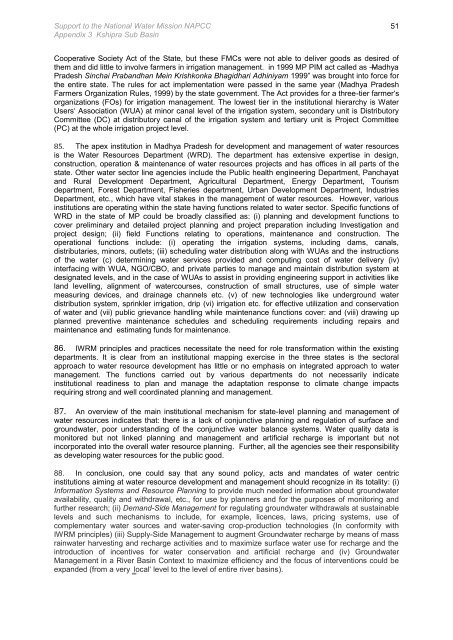Kshipra Sub Basin - Asian Development Bank
Kshipra Sub Basin - Asian Development Bank
Kshipra Sub Basin - Asian Development Bank
Create successful ePaper yourself
Turn your PDF publications into a flip-book with our unique Google optimized e-Paper software.
Support to the National Water Mission NAPCC<br />
Appendix 3 <strong>Kshipra</strong> <strong>Sub</strong> <strong>Basin</strong><br />
Cooperative Society Act of the State, but these FMCs were not able to deliver goods as desired of<br />
them and did little to involve farmers in irrigation management. in 1999 MP PIM act called as ―Madhya<br />
Pradesh Sinchai Prabandhan Mein Krishkonka Bhagidhari Adhiniyam 1999‖ was brought into force for<br />
the entire state. The rules for act implementation were passed in the same year (Madhya Pradesh<br />
Farmers Organization Rules, 1999) by the state government. The Act provides for a three-tier farmer‘s<br />
organizations (FOs) for irrigation management. The lowest tier in the institutional hierarchy is Water<br />
Users‘ Association (WUA) at minor canal level of the irrigation system, secondary unit is Distributory<br />
Committee (DC) at distributory canal of the irrigation system and tertiary unit is Project Committee<br />
(PC) at the whole irrigation project level.<br />
85. The apex institution in Madhya Pradesh for development and management of water resources<br />
is the Water Resources Department (WRD). The department has extensive expertise in design,<br />
construction, operation & maintenance of water resources projects and has offices in all parts of the<br />
state. Other water sector line agencies include the Public health engineering Department, Panchayat<br />
and Rural <strong>Development</strong> Department, Agricultural Department, Energy Department, Tourism<br />
department, Forest Department, Fisheries department, Urban <strong>Development</strong> Department, Industries<br />
Department, etc., which have vital stakes in the management of water resources. However, various<br />
institutions are operating within the state having functions related to water sector. Specific functions of<br />
WRD in the state of MP could be broadly classified as: (i) planning and development functions to<br />
cover preliminary and detailed project planning and project preparation including Investigation and<br />
project design; (ii) field Functions relating to operations, maintenance and construction. The<br />
operational functions include: (i) operating the irrigation systems, including dams, canals,<br />
distributaries, minors, outlets; (iii) scheduling water distribution along with WUAs and the instructions<br />
of the water (c) determining water services provided and computing cost of water delivery (iv)<br />
interfacing with WUA, NGO/CBO, and private parties to manage and maintain distribution system at<br />
designated levels, and in the case of WUAs to assist in providing engineering support in activities like<br />
land levelling, alignment of watercourses, construction of small structures, use of simple water<br />
measuring devices, and drainage channels etc. (v) of new technologies like underground water<br />
distribution system, sprinkler irrigation, drip (vi) irrigation etc. for effective utilization and conservation<br />
of water and (vii) public grievance handling while maintenance functions cover: and (viii) drawing up<br />
planned preventive maintenance schedules and scheduling requirements including repairs and<br />
maintenance and estimating funds for maintenance.<br />
86. IWRM principles and practices necessitate the need for role transformation within the existing<br />
departments. It is clear from an institutional mapping exercise in the three states is the sectoral<br />
approach to water resource development has little or no emphasis on integrated approach to water<br />
management. The functions carried out by various departments do not necessarily indicate<br />
institutional readiness to plan and manage the adaptation response to climate change impacts<br />
requiring strong and well coordinated planning and management.<br />
87. An overview of the main institutional mechanism for state-level planning and management of<br />
water resources indicates that: there is a lack of conjunctive planning and regulation of surface and<br />
groundwater, poor understanding of the conjunctive water balance systems. Water quality data is<br />
monitored but not linked planning and management and artificial recharge is important but not<br />
incorporated into the overall water resource planning. Further, all the agencies see their responsibility<br />
as developing water resources for the public good.<br />
88. In conclusion, one could say that any sound policy, acts and mandates of water centric<br />
institutions aiming at water resource development and management should recognize in its totality: (i)<br />
Information Systems and Resource Planning to provide much needed information about groundwater<br />
availability, quality and withdrawal, etc., for use by planners and for the purposes of monitoring and<br />
further research; (ii) Demand-Side Management for regulating groundwater withdrawals at sustainable<br />
levels and such mechanisms to include, for example, licences, laws, pricing systems, use of<br />
complementary water sources and water-saving crop-production technologies (In conformity with<br />
IWRM principles) (iii) Supply-Side Management to augment Groundwater recharge by means of mass<br />
rainwater harvesting and recharge activities and to maximize surface water use for recharge and the<br />
introduction of incentives for water conservation and artificial recharge and (iv) Groundwater<br />
Management in a River <strong>Basin</strong> Context to maximize efficiency and the focus of interventions could be<br />
expanded (from a very ‗local‘ level to the level of entire river basins).<br />
51
















